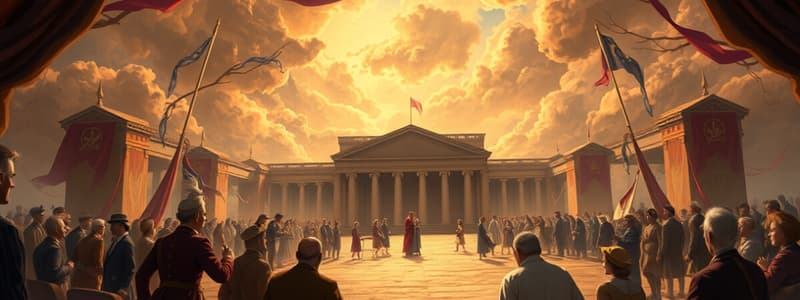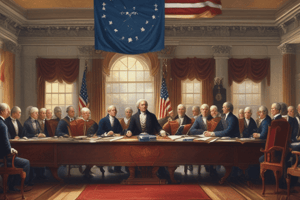Podcast
Questions and Answers
What was the Constitutional Convention?
What was the Constitutional Convention?
- A formal meeting in Philadelphia in 1787 (correct)
- An informal gathering of state leaders
- A meeting to revise the Articles of Confederation (correct)
- A conference on state governance
Who is known as the 'Father of the Constitution'?
Who is known as the 'Father of the Constitution'?
James Madison
What issue is addressed by the 3/5 Compromise?
What issue is addressed by the 3/5 Compromise?
- The structure of the legislature
- How to handle the representation of enslaved persons (correct)
- The election of the President
- The regulation of foreign trade
What is the Legislative Branch also called?
What is the Legislative Branch also called?
What does Proportional Representation mean?
What does Proportional Representation mean?
What was the outcome of the Great Compromise?
What was the outcome of the Great Compromise?
What does the Bill of Rights consist of?
What does the Bill of Rights consist of?
What was an opinion regarding how to elect the President?
What was an opinion regarding how to elect the President?
What was the result of the 3/5 Compromise?
What was the result of the 3/5 Compromise?
Flashcards are hidden until you start studying
Study Notes
Constitutional Convention
- Formal meeting in Philadelphia in 1787 aimed at creating the U.S. Constitution to address the shortcomings of the Articles of Confederation.
Great Compromise
- Resolved the disagreement on legislative structure by combining the Virginia Plan's proportional representation and the New Jersey Plan's equal representation, resulting in a bicameral legislature.
James Madison
- Known as the "Father of the Constitution," he was a chief architect of the government framework adopted at the Convention, advocating for a strong national government.
3/5 Compromise
- Established that each enslaved person would count as three-fifths of a person for both representation in the House of Representatives and taxation purposes, creating an imbalance that contributed to the Civil War.
Legislative Branch
- Consists of two parts: the House of Representatives and the Senate, responsible for making laws, imposing taxes, declaring war, and ratifying treaties.
Presidential Election Compromise
- Delegates debated between congressional election and direct election by the people for the President's selection.
Proportional Representation
- Determined that the number of representatives in the House would be based on the state population, favoring larger states.
Regulation of Trade Compromise
- Resolved disagreements on regulating foreign and interstate trade, which had varying opinions among delegates.
Equal Representation
- Ensured that every state would have the same number of representatives in the Senate, regardless of population size.
Opinions of the Great Compromise
- Virginia Plan proposed two houses with representation based on population.
- New Jersey Plan suggested a single house with equal representation from each state.
The New Jersey Plan
- Proposed a one-house legislature with equal representation for each state, aimed at maintaining the Articles of Confederation but with enhancements allowing Congress to levy taxes and regulate trade.
Opinions of the 3/5 Compromise
- Differing views on counting enslaved individuals for representation and taxation, leading to conflicting positions during negotiations.
Opinions of the Presidential Election Compromise
- Delegates split on whether Congress should elect the president or if the people should have direct election rights.
Three-Fifths Compromise
- Each enslaved person counted as 3/5 of a free person in terms of state population for House representation and taxation, exacerbating sectional tensions.
Result of the Great Compromise
- Established a bicameral legislature: House of Representatives based on population (proportional representation) and Senate with two representatives from each state (equal representation).
Bill of Rights
- A set of ten amendments added to the Constitution to protect individual liberties by limiting governmental powers.
Studying That Suits You
Use AI to generate personalized quizzes and flashcards to suit your learning preferences.





